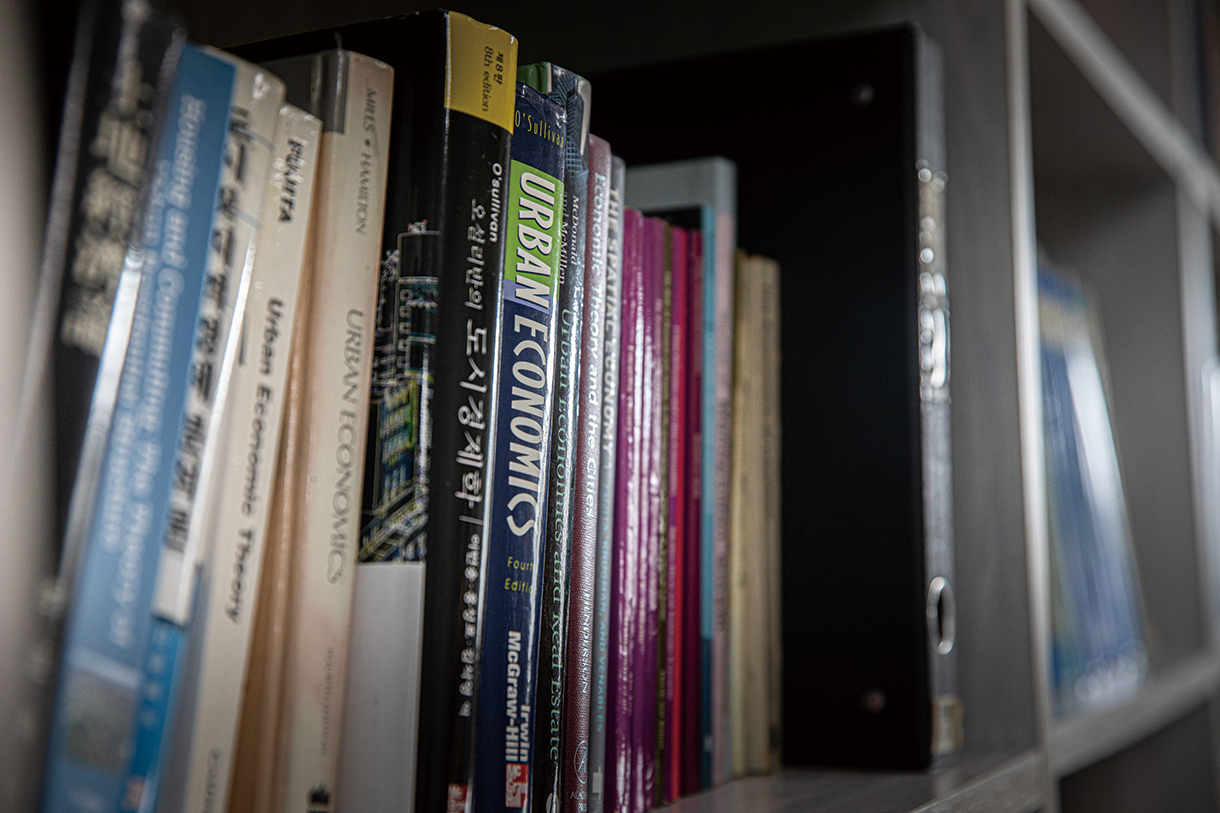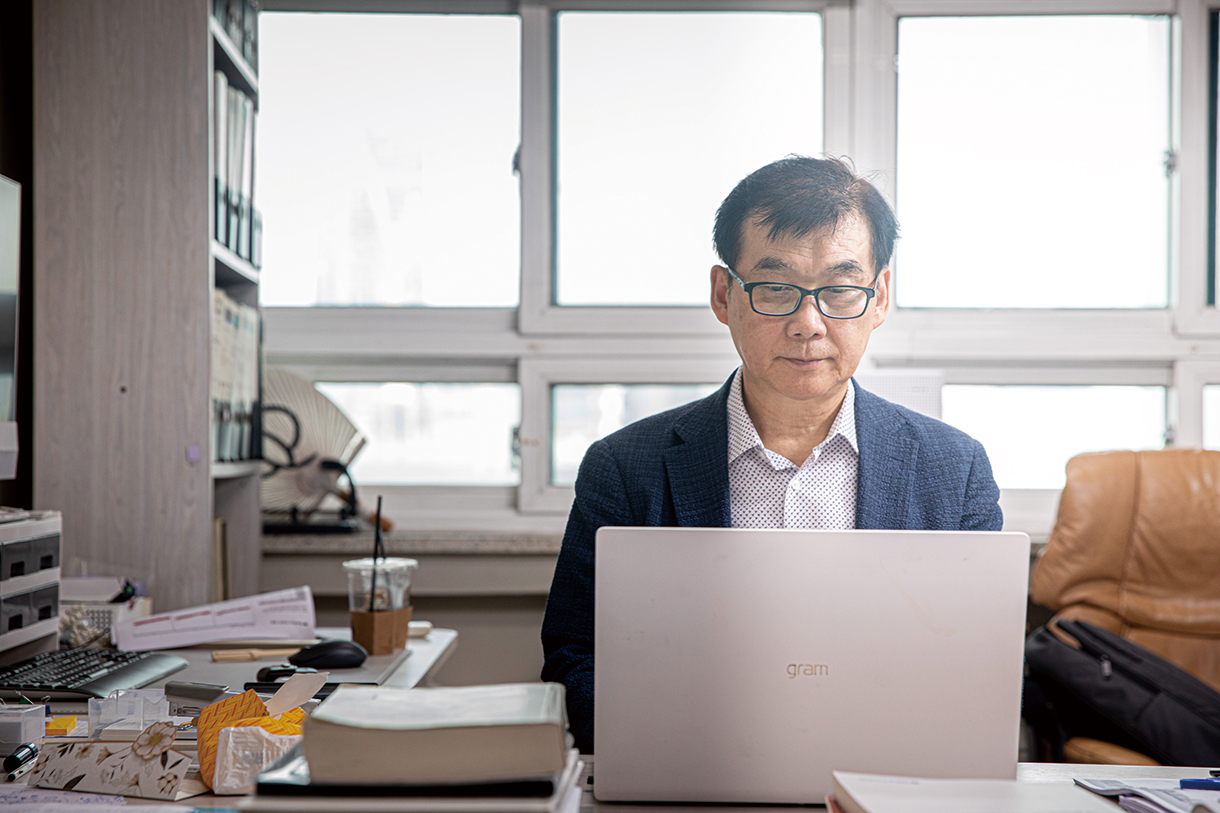

Story
집적의 명암이 공존하는 도시,
우리가 풀어야 할 과제는?
Cities with Pros and Cons of Density
What Are Our Challenges?
도시공학과 이창무 교수
Prof. Lee, Chang-Moo, Department of Urban Planning & Engineering
- 글 박영임
- 사진 손초원
- Writing Park Yeong-im
- Photograph Son Cho-won
Scroll Down
Urban environment refers to the natural, living, and spatial environments of a city. It is a concept that encompasses topography, climate, water resources, vegetation, animals and plants, population, water quality, atmosphere, waste, noise, vibration, traffic, and landscape. How, then, should we develop the urban environment? We met with Professor Lee, Chang-Moo, who has been engaged in various activities related to urban planning and development, and talked about the urban environment of Korea and the future cities we should pursue.
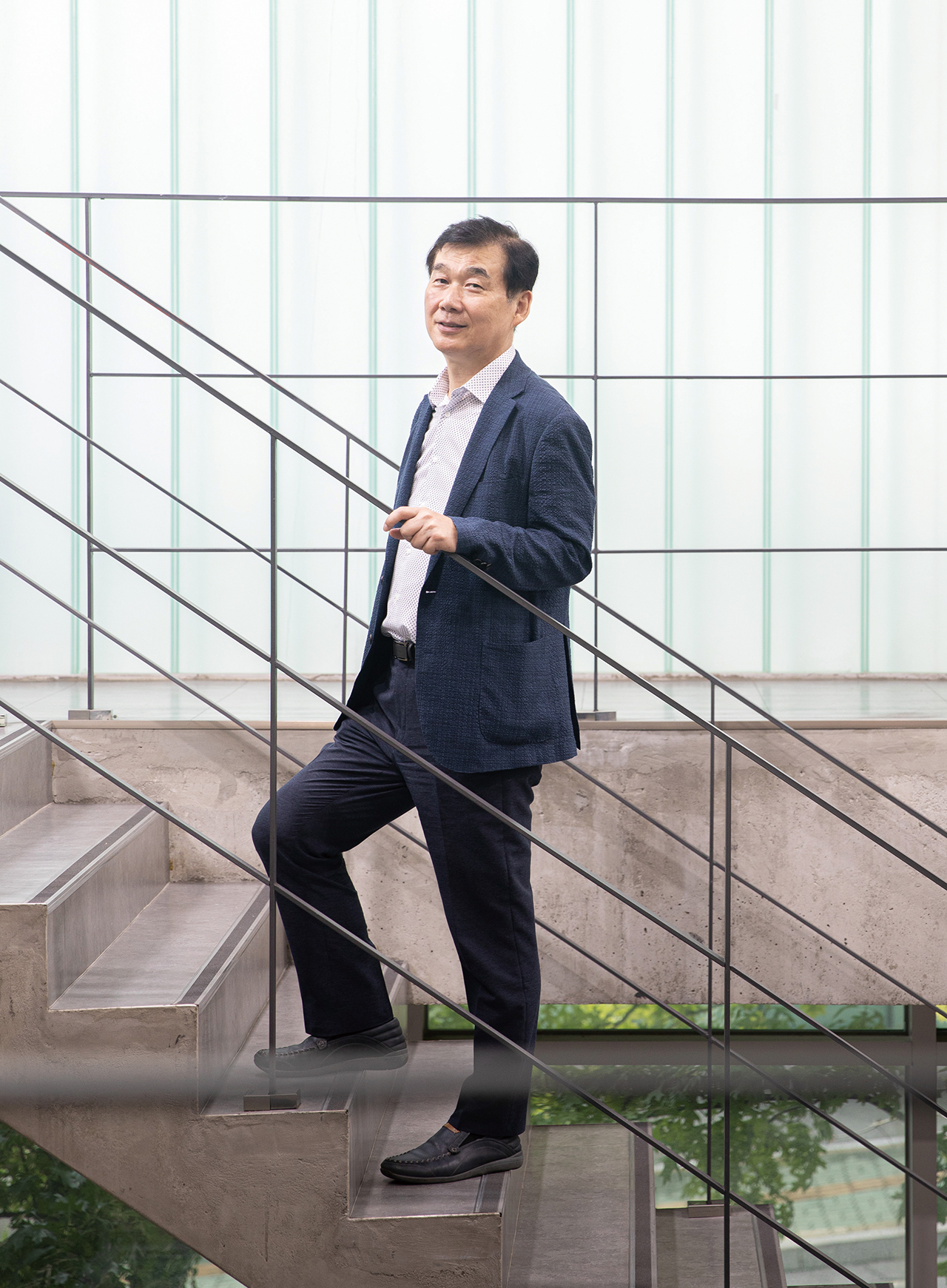
인구가 현저하게 집적한 곳, 도시
강철과 엘리베이터가 발명되자 1899년 건축가 루이스 설리번은 미국 시카고에 12층짜리 ‘카슨 피리 스콧 백화점’을 설계했다. 이로써 마천루의 시대가 열렸고, 이는 곧 고밀화 도시의 탄생을 불렀다. ‘도시’는 상공업을 중심으로 한 경제, 행정, 문화, 교통망, 편의시설 따위의 중심지이자 인구가 몰려 그 밀도가 현저하게 높은 지역을 이르는 말이 됐다. 이창무 교수는 도시와 관련된 가장 중요한 개념은 결국 물리적 시설들을 이용하는 사람들의 집적도라고 말했다.
“정주 공간에 대해 인지하는 물리적인 특성이 도시를 정의하는 가장 중요한 특징이라 할 수 있습니다. 주택이 듬성듬성 형성된 농촌과 비교해 도시는 집들이 포개져 있어 굉장히 집적돼 있고 입체적인 토지 이용이 이뤄지죠. 그 때문에 시각적으로도 도시라는 공간을 쉽게 인지할 수 있습니다. 그리고 그 안에서 강도 높은 밀도로 다양한 활동들이 담겨집니다.”
도시라는 공간은 인간의 다양한 활동이 집적되는 곳이기에 그런 활동을 담을 수 있는 물리적인 공간과 시설들로 이뤄진다. 예를 들면, 주거라는 기본 활동을 담는 주택과 생산활동을 위한 사무실, 공장, 그리고 소비활동을 위한 쇼핑센터, 멀티플렉스 같은 위락시설 등이 들어선다. 각각의 시설이 같은 공간 내에 분포하면서 적정한 관계를 맺고 서로 연결돼야 한다. 이를 위해 이동을 위한 도로나 지하철이 설계되고, 그 밖에 상하수도, 전기 같은 인프라가 일종의 혈관처럼 기능하게 된다.
“도시가 형성되고 유지되는 가장 근본적인 원인은 여러 활동의 주체가 되는 사람들이 공간적으로 집적해 생활하고 활동하면서 발생하는 경제적 시너지 효과입니다. 여러 산업이 도시에 모이면 도시화경제라는 추가적인 시너지가 발생하죠. 적은 노력으로 더 많은 생산과 성과를 만들어낼 수 있는 장소인 것입니다.”
Cities, where population is concentrated
With the invention of steel and elevators, architect Louis Sullivan designed the 12-story building, Carson Pirie Scott Department Store, in Chicago, USA, in 1899. This was the start of the era of skyscrapers, which soon led to the birth of the densification of cities.
A “city” has come to refer to a center of a nation's economy, administration, culture, transportation networks, and convenience facilities based on commerce and industry, and an area with significantly high density due to a large population. Professor Lee believes that the most important aspect of a city is the concentration of people using material facilities in it.
“The perceived physical characteristics of the settlement would be the most important characteristic that defines a city. Compared to rural areas where houses are sparsely located, cities are very concentrated, with homes stacked up on top of each other, and where land is very tightly used. This is why we can easily recognize a city visually. And within a city, a variety of activities are carried out with high intensity and density.”
Since cities are places where various human activities are concentrated, they are made up of physical spaces and facilities that can accommodate such activities. For example, there are houses and apartments for basic activities of living, offices and factories for production activities, shopping centers for consumption activities, and entertainment facilities such as multiplexes. Each facility must be in the same space, connected to each other, and interrelated with each other. Roads and subways for transportation are developed, and other infrastructure such as water supply, sewage, and electricity function like blood vessels.
“The most fundamental reason why a city is formed and maintained is the economic synergy that results from the spatial concentration of people living and working in different activities. When multiple industries are concentrated in a city, additional synergy called the urbanization economy occurs: a place where more can be produced and accomplished with less effort.”
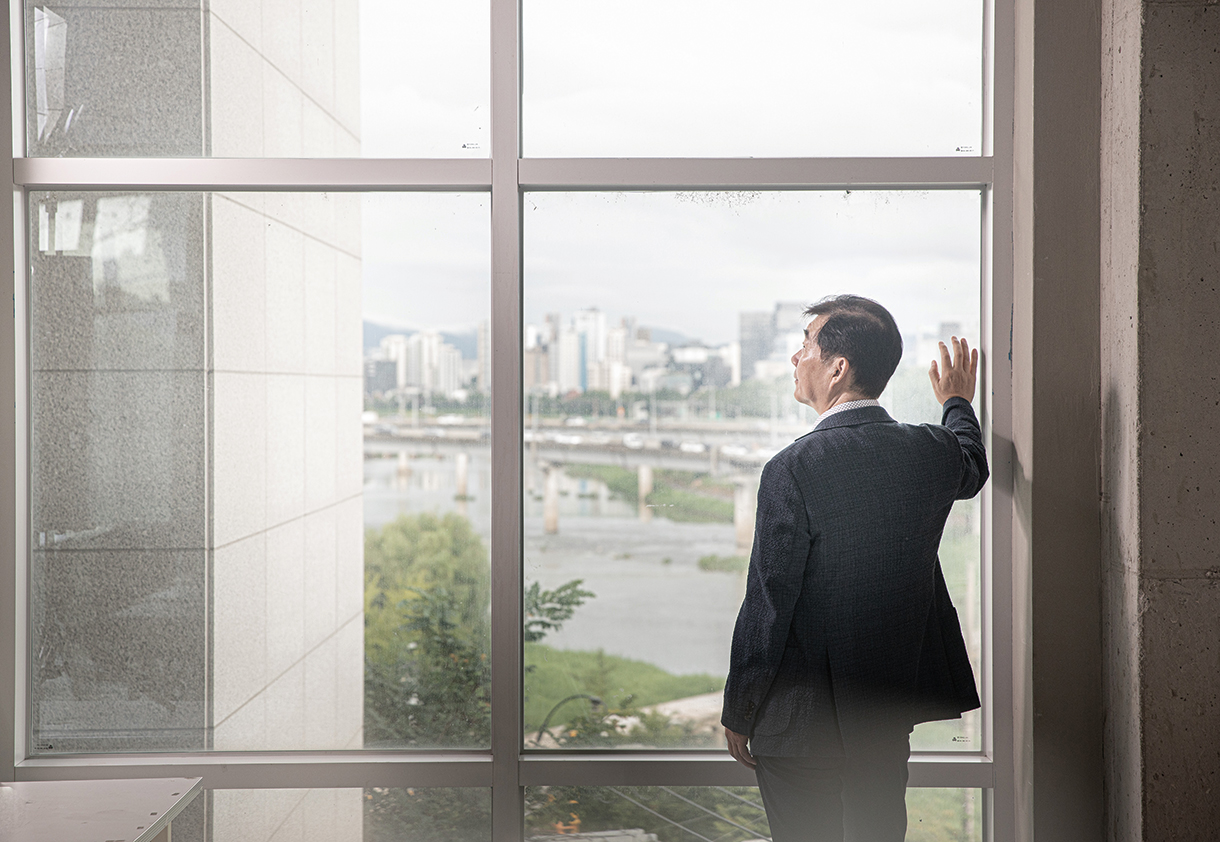
집적 이익은 확대, 비용은 최소화
하지만 인간의 집적이 긍정적인 효과만 낳는 것은 아니다. 반대급부적으로 문제도 발생한다. 이를테면 주택문제, 교통문제, 환경문제 등이 있다. 이는 집적에 따른 사회적 비용이다. 그래서 도시 내 용도별 공간과 시설을 합리적으로 배치하고, 대중교통 체계를 개선하며, 녹지를 구성하는 등 도시의 문제를 관리해야 한다.
인구 941만 명의 서울, 그리고 330만 명의 부산 등 우리나라 도시는 다른 나라의 도시들과 비교해 아파트 등 공동주택 중심으로 주거지가 형성된 점이 특징이다. 산업화 시기 급격히 도시화가 진행되면서 주택공급은 심각한 사회문제가 됐고, 이 문제를 효율적으로 해결하기 위한 방안으로 떠오른 것이 아파트였다. 동질적이고 획일적인 환경 속에서 사람들은 높은 상호작용을 하지만, 한편으로는 이러한 상호작용이 정서적 갈등을 조장하기도 한다.
“아파트 위주로 형성된 도시라는 물리적인 모습은 거부하기 힘든 우리나라 도시들의 특징입니다. 이는 단점이자 장점으로 작용합니다. 산업화 시기에 쇠퇴한 도시들도 있는데, 우리나라 대도시는 집적화된 토지 이용 형태 덕분에 지속적인 성장을 이뤘고, 효율성을 높일 수 있었습니다. 대신 수도권과 비수도권, 수도권 안에서도 서울과 비서울, 서울 안에서도 도심과 외곽, 강남과 강북 등 지역균형 발전에 대한 논란이 끊이지 않았습니다.”
이창무 교수는 도시가 커지면 당연히 음의 외부 효과도 동반되기 마련이므로 많은 사람이 모여서 생기는 집적의 이익은 늘리고, 사회적 비용은 최소화하는 것이 도시 문제 해결의 기본 전제라고 강조했다.
Increase benefits, minimize costs
However, human concentration does not have only positive effects. In return, it also causes problems. For example, there are housing, traffic, and environmental problems.
These are the social costs of urban concentration. Therefore, it is necessary to manage these problems by rationally arranging spaces and facilities within the city for each use, improving public transportation systems, and organizing green spaces.
Unlike cities in other countries, cities in Korea, such as Seoul with a population of 9.41million and Busan with a population of 3.30 million, are characterized by residential areas centered on apartment buildings. As urbanization progressed rapidly during the industrialization period, housing supply became a serious social problem. Apartments were thus an efficient solution to this problem. People are highly interactive in a homogeneous and uniform environment, but on the other hand, this interaction also causes emotional conflicts.
“The physical features formed mainly of apartments are the undeniable characteristics of Korean cities. This is both an advantage and a disadvantage. Some global cities declined during the industrialization era, but Korea’s large cities have continued to grow and become more efficient thanks to the concentrated land use. However, there was constant controversy over balanced regional development, between metropolitan and nonmetropolitan areas, between Seoul and other parts within the metropolitan area, between the city center and outskirts within Seoul, and between Gangnam and Gangbuk areas.”
Professor Lee emphasized that the basic premise of solving urban problems is to increase the benefits of concentration and minimize the social costs, as negative external factors are bound to follow when cities grow.
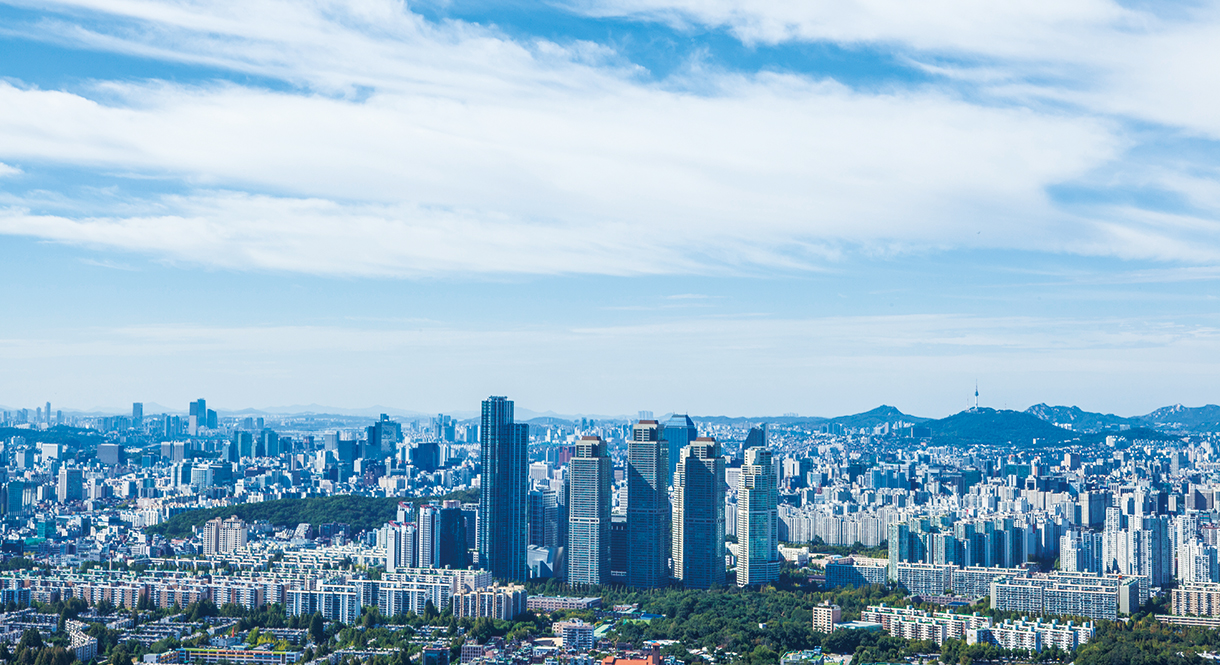
도시라는 공간은 인간의 다양한 활동이 집적되는 곳이기에 그런 활동을 담을 수 있는 물리적인 공간과 시설들로 이뤄진다
A city is a place where various human activities are concentrated, and it comprises physical spaces and facilities that can accommodate such activities.
기술적 진보가 가져올 도시의 미래
도시는 생물처럼 시대에 따라 변하며 발전하거나 혹은 사라진다. 역사적으로 수많은 도시가 생성됐지만, 시대 변화에 적응하지 못해 도태되기도 했다. 그렇다면 오늘날의 도시들은 어떠한 시대적 과제를 안고 있을까.
“과거 인구 성장기에는 넘쳐나는 인구를 수용하기 위해 그린벨트를 넘어 신도시를 개발했습니다. 하지만 인구가 감소하고 고령화되면 장시간 출퇴근을 감수하기 어렵죠. 그래서 도심에 밀집된 콤팩트 시티의 형태로 변모해야 합니다. 축소 도시는 어쩔 수 없이 신규 택지 개발이 아니라 재건축, 재개발 같은 정비사업을 통해 도심의 밀도를 높이는 방향으로 바꿔나가야 합니다.”
한편, 최근 기후변화 및 감염병 팬데믹이 사회적으로 중요한 화두로 대두됐는데, 이는 인류뿐 아니라 도시도 풀어야 할 숙제다. 따라서 도시개발 시 기후변화를 비롯한 자연재해 및 질병을 관리하는 규정을 강화해야 한다. 과거 100년 만에 한 번 올까 말까 한 홍수가 이제는 20년도 안 되어 반복된다. 홍수나 집중호우를 감당하려는 도시 인프라 구축의 기준이 강화돼야 한다. 또한 예로부터 도시는 감염병에 취약한 구조였으므로, 외곽으로 근무지를 분산하는 등 도시공간 구조를 새롭게 재편해야 한다.
사우디아라비아의 네옴시티 등 세계적으로 첨단 미래 도시를 개발하는 프로젝트가 진행되고 있다. 과연 미래 도시는 어떠한 가치를 담아야 할까.
“도시란 적응과 혁신의 장소이지 실험의 장소는 아닙니다. 향후 도시의 장기적인 과제는 기술적 진보를 수용하고 혁신을 만들어내는 것입니다. 4차 산업혁명이나 AI 같은 기술적 진보는 인간 삶의 모습을 변모시킬 것이므로 도시도 그에 대응해야 합니다. 토지 이용 형태가 달라질 수밖에 없죠. 굴뚝 없는 산업이 발전하면 주거지역에도 생산시설이 공존할 수 있습니다.”
이창무 교수는 배타적인 용도지역제에서 탈피해 4차 산업혁명으로 달라진 산업구조를 담을 수 있는 복합용도 및 입체적인 용도, 화이트 조닝(white zoning; 토지 용도의 사전 지정 없이 개발사업자의 아이디어를 공공과의 협의를 통해 실현해내려는 토지이용제도) 같은 제도적 혁신이 요구된다고 전했다. 또한 인간의 생산 기능이 약화되면서 서비스 및 소비 기능이 강화될 테니 도시도 이를 담아내야 한다고 덧붙였다. 이렇게 도시란 변화를 수용하며 혁신의 장소로 기능해야 장기적인 생명력을 얻을 수 있다. 이창무 교수는 그런 의미에서 한양대가 서울시의 혁신 장소로 기능할 수 있다고 강조했다.
“서울 도심에 위치한 캠퍼스 내로 지하철역 입구가 연결돼 있습니다. 또 자생적 혁신 장소인 성수동의 성장을 공유할 수 있죠. 이런 입지적 특수성 덕분에 한양대야말로 서울시의 혁신 장소로 기능할 수 있습니다. 한양인이 이러한 가능성을 마음껏 활용할 수 있기를 바랍니다.”
The future of cities as technology advances
Cities, like living things, change, develop, or disappear over time. Historically, many cities have been created, only to be eliminated by their inability to adapt to changing times. So, what are the challenges facing today’s cities?
“In the past, during the periods of population growth, new cities were developed beyond the green belts to accommodate the overflowing population. However, as population declines and ages, long commutes become more difficult. Therefore, they must change to living in compact city spaces, densely packed in the urban centers. Compact cities have to adapt to increasing density of the city centers through maintenance projects such as reconstruction and redevelopment, rather than development of new housing sites.”
Meanwhile, climate change and pandemic diseases have recently emerged as important social topics, which are challenges not only for humanity, but also for cities. Therefore, regulations to manage natural disasters including climate change and diseases must be strengthened for urban development. Floods that used to come once every 100 years are now recurring every 20 years or less. Standards for building urban infrastructure to cope with floods and heavy rain must be reinforced. In addition, since cities have long been vulnerable to infectious diseases, the urban spatial structure must be reorganized by dispersing workplaces to the outskirts, etc.
Projects to develop high-tech future cities are underway around the world, in places such as Neom, Saudi Arabia. Then, what values should future cities encompass?
Professor Lee explains, “Cities are places for adaptation and innovation, not for experiments. The long-term challenge for cities in the future would be to adopt technological advancement and create innovation. Technological advancement such as the Fourth Industrial Revolution or AI will change the lives of humans, and the cities also must respond to it. Land-use is bound to change. If chimneyless industries develop, production facilities can be built also in residential areas.”
Professor Lee adds that institutional innovation is required, such as white zoning (a system that seeks to realize developers’ ideas through consultation with the public instead of prior designation of the land use) for mixed-use and three-dimensional use to accommodate the industrial structure changed by the 4th Industrial Revolution. He also added that, as human production functions weaken, the service and consumption functions will have to improve, and the cities must also accommodate this. In this way, a city can gain longevity only by accepting changes and functioning as a place for innovation. In this sense, Professor Lee emphasized that Hanyang University can function as a place for innovation in Seoul.
“A subway entrance is connected to the campus located in the city center of Seoul. It also shares the growth of Seongsu-dong, a place of self-sustaining innovation. Thanks to this unique location, Hanyang University can function as a place for innovation of Seoul. I hope that members of Hanyang University can take full advantage of this possibility.”
